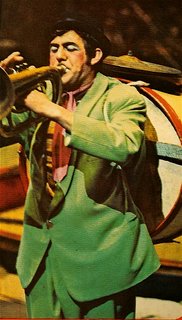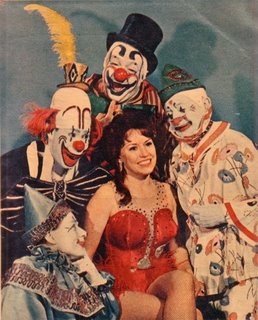
Where to begin? What to leave out?
I suppose the start is obvious.
Hubert Jean Charles Cairoli. (Some sources have it as
"Jean Hubert Charles".)
Born: Milan, Italy. 15 February 1910.
Died: Blackpool, England. 17 February 1980.
A friend of mine once heard a girl tell Charlie that
he wasn't a real clown, probably because she believed
a real clown had a heavy facial make-up. His response
was "Oh!", and a big smile.
If Charlie Cairoli wasn't a real clown, then there is
no such thing as a real clown.
Whilst he was born in Italy, his parents were both
French, and it was their only visit to that country.
Charlie made his ring debut at the age of 7, and by
1929 he was working at Cirque Medrano in Paris,
France, in an act with his father (Jean-Marie) as
white-face, and the celebrated auguste, Porto. By this
time, Charlie was known as Carletto. The Cairolis were
to remain at Medrano until 1937, Charlie's elder
brother, Filip, replacing Porto along the way.
For much of that time, the other major Parisian circus
building (Cirque d'Hiver) featured Les Fratellini.
Naturally there was professional rivalry (and respect)
between the two star clown trios, and each sent family
members to the other building to spy on their
competitors.
Charlie would notice the frequent presence of one
particular charming young lady in his audience, so
made sure he met her. He discovered that her name was
Violette. Violette Fratellini. Her father was Paul.
The result was marriage (despite some initial
opposition from both families) and, subsequently, 3
children (2 daughters and a son).
The year 1939 found the Cairolis at Blackpool Tower
Circus, where they were very successful. Filip
returned to France when war broke out, but father and
younger son stayed on in Britain, often billed as The
Cairoli Brothers when working in variety when the
circus wasn't operating. Having been born in Italy,
Charlie was interned towards the start of hostilities,
but eventually he would perform 2 shows each day - and
then spend the night working in a munitions factory.
Charlie Cairoli remained a fixture a The Tower until
his retirement at the end of the 1979 season, a season
during which his health had not been good.
"Johnny" Cairoli retired in 1947, after which Charlie
worked with 4 different white-face clowns, namely Paul
Freeman, Paul King, Paul Conner and, to complete the
circle, Charlie Cairoli Jr. (The photo with the
posting on 8 July shows Paul King.)
Featured prominently, there would often be a brilliant
stooge called Jimmy Buchanan. Jimmy worked absolutely
straight-faced. Dead pan. Even whilst his nose or ears
were severely tweaked - and with a mouth full of
water.
Violette Cairoli and Jimmy Buchanan have both departed
this life.
However, Charlie Junior still works as a clown,
although he took some time out from circus, and
dropped the "Junior" a while ago. Of late, he's been
in and out of hospital, so is resting as I write. He
and his wife Claudi (more formally Claudette) have 2
sons - Charles and Alexander - who have little or no
interest in show business.
I know that a grandchild of Filip Cairoli was living
in the US some 10 years ago.
That tells you something about the man and his
colleagues. In due course, I'll tell you something
about his work.
John Cooper.
England.









